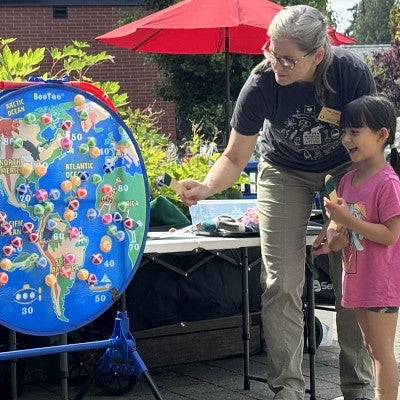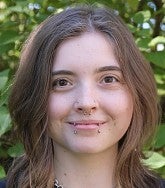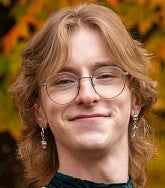How I spent my summer vacation: student educators bring science to towns across Oregon
The annual outreach by the Museum of Natural and Cultural History means as much to the students who give the talks as to the communities that host them
You can learn a lot about a town by locking your keys in your car.
University of Oregon student Kali Bissanti discovered this in summer 2023, as an outreach educator with the university’s Museum of Natural and Cultural History. Bissanti was in Union, a small town in northeast Oregon, when this predicament emerged, just 40 minutes before Bissanti was scheduled to give a talk at the Union Carnegie Public Library.
Bissanti called museum education manager Mia Jackson in a panic. While Jackson talked Bissanti down, Union — population 2,100 — sprang into action. The librarian called the sheriff. The sheriff called the mayor. The mayor called the fire chief. The fire chief told the mayor about a guy in town, Bissanti said, “who can open car doors when they’re locked.” The young man arrived in minutes and soon Bissanti was back into the museum van and back on schedule.
“After my program this lady came up to me and said, ‘By the way, my son’s the one who opened the car for you,’” Bissanti said, laughing. “It’s so cool to see a community come together like that. The fact that everybody knows everybody is awesome. A really special part of this job are these communities — to be able to go to these places and feel accepted by them and to be able to support them with these programs is really fulfilling.”
While many of us spent the summer resting and relaxing, five students employed by the museum crisscrossed the state, driving more than 10,000 miles and giving more than 100 science presentations in towns the size of Union, or smaller. This is the Museum of Natural and Cultural History summer outreach program: one woman’s brainstorm for sharing museum programming statewide and an effort that means as much to student educators like Bissanti as to the rural communities that host them.
The museum is nearly as old as the university — it dates to the late 1800s, when geologist Thomas Condon joined the UO and contributed his extensive fossil collection. As the official repository for Oregon’s archaeological and paleontological material, the museum is committed to serving every corner of the state with educational programs; it occurred to Jackson that the museum could partner with public libraries in rural areas to reach kids and their families over the slower summer months.

“The idea was to get out into communities that don’t have museums and lots of cultural resources at their beck and call,” she said. “I know that public libraries are the front line of community education, especially in small rural areas, and they have the family audience during the summer.”
In 2015, Jackson launched the outreach: UO students, hired by the museum, traveling the state to provide educational presentations that match rural libraries’ summer reading programs. The students deliver short, entertaining and interactive talks that are followed by activities, games and crafts, all covering topics such as paleontology, geology, space and the environment.
To say the outreach has proven popular is an understatement. Over 10 years, the program has expanded to include all but two of Oregon’s 36 counties and the kids and adults reached has grown five-fold, to 5,500 annually.
“It was a great hit,” said Dovie Wood, assistant librarian at the Grant County Library in John Day, which hosted the program in July. “It’s fairly inexpensive to get them here and they just did a wonderful job. It means the world to the parents, who are trying to get their kids doing something besides running the streets and being naughty.”
“We’re about an hour from the border to Idaho — we are so far from everybody and we are just starved for things like this,” added Missy Grammon, youth services coordinator for the Baker County Library District. “We have so many different age-level kids — 2-year-olds to 12-year-olds — and [the outreach program] is a leveled education that can appeal to every learner. It’s amazing.”

Jackson had trained to become a teacher when she took a job with a small science museum in Alaska. That was 30 years ago, and she never left museum education; she calls the field a lesser known but important part of the education ecosystem, delivering general knowledge to communities of every stripe.
With help from museum education coordinator Cessna Strand, Jackson creates the outreach programming each year and hires four or five UO students. She trains them for a month on the presentations and travel concerns, then the students set out in pairs to every corner of the state.
I went to Dora, Oregon, in 2024. It was like, driving on a road with nobody on it for three hours. The town was the library. There was a pole that said, “Stand here for cell service.” You have to stand directly next to the pole to get any service. It’s really cool when you’re in the small towns because they really appreciate it.
—Rowan Dodero, museum outreach educator
The contributions of the students are remarkable. They must master the science presentation and supporting activities, deliver everything engagingly to crowds of every size (and kids of every temperament) and conduct themselves responsibly while spending as many as five days on the road. They manage their accommodations, schedule and other logistics while traveling to libraries in Cornelius and Canyonville, Prineville and Port Orford, Monroe, McMinnville, Monmouth and dozens more.
The students all credit Jackson for providing the copious preparation and patience necessary for success. Said Fynne Stoessl: “Mia is probably the best boss I will ever have.”
Stoessl, who graduated in June, applied for the outreach position with a love of the museum . . . and a deep fear of public speaking.

Jackson helps the students overcome stage fright and polish their talks by recording their presentations and critiquing them. Her combination of trust, firmness and understanding made the difference for Stoessl, who completed her second year as an outreach educator in August and has found in this work what she wants in a career.
“Mia is completely entrusting this job to us,” Stoessl said. “She is trusting us to wake up on time, to learn the presentations, to deliver it professionally and appropriately. She doesn’t ever scold us, she says, ‘You did great, keep practicing.’ She is stern when she needs to be and I respect her when she is stern because of the patience she holds for us. It makes me feel capable that I can do it and it inspires me to give back the best that I can.”
Last year we were in Pendleton and just killing time and we walked into this store that had all these fossils, taxidermy and pelts. This man running the store comes out and starts talking to us. He’s asking about our work, we tell him we teach kids, and he gets really interested — he loves to teach kids, apparently he has a past in it. He brings out this little Tupperware filled with fossilized shark teeth and they’re beautiful and he says, “I really want you to give these to the kids.” He misses teaching kids. We went to the library that night and we were able to hand out these fossilized shark teeth — the kids were so excited. It was such an awesome gesture.
—Fynne Stoessl, museum outreach educator
The university recently identified priorities critical for its future, among them doing more to help students succeed at the UO and prepare for careers. Jackson cited a laundry list of marketable skills that the student educators sharpen through the program: public speaking, team building, interpersonal relations and event management, among them.
Rogan deCalesta, who graduated in June with a journalism degree, said being an outreach educator has helped him move toward his dream of a career that could prove as challenging as it is fulfilling: communicating about the climate.

His appetite for this work was whetted during an internship with Earth to Sky, a partnership between NASA, the National Park Service and the U.S. Fish and Wildlife Service that supports science communicators and educators. But given the divisiveness of the climate change issue, deCalesta said, he’ll need to learn to find common ground with audiences to be effective.
Because climate change was the subject of this summer’s programming, deCalesta had plenty of opportunities to try to impart information without sparking arguments.
“Learning how to meet people in the middle is absolutely essential for a communicator,” he said. “To practice that, that will serve me no matter where I go, no matter what field — politics, documentaries. That ability to talk to someone — to hear their opinions and them listen to yours — that is very valuable. It’s, ‘I know I care about the climate, I think you care about the climate, let’s find the thing about the climate that we both care about, and then build on it.’”
In Paisley, we pulled in at sunset. We didn’t see a single person. It was dead silent. There was a single stoplight right off the road. You wake up, you step outside, you can look down a street and you can see the whole town by looking right and looking left. It’s gorgeous out there. The golden wheat and grass, all the shades of yellow, and the sunsets are gorgeous, very dull pink. I’ve seen so many amazing sunsets.
—Rogan deCalesta, museum outreach educator
In Philomath (population: 5,800), the sidewalks downtown gleamed on a Thursday morning in July. Logging trucks rumbled down Main Street, where banners hanging from lampposts promoted an upcoming rodeo and celebrated Philomath High School’s class of 2025.
Outside the Philomath Community Library, museum outreach educators Rowan Dodero and Bear Elliott set up displays and games while a dozen or so kids and adults arrived and took seats.
Among them was Hazel Reninger, who learned of the event just that morning and rushed over with her kids Zendaya, 5, and Aiden, 3. Following Dodero’s presentation on Earth and its climate, Reninger’s kids were turned loose with the others to explore games and crafts.
Zendaya and Aiden gravitated to “sail cars,” an activity that introduces kids to wind power as a renewable energy. After attaching small paper sails to toy cars, they placed the vehicles before a blowing fan that sent the creations rolling down a track. As quickly as Reninger could record her daughter’s test drive on her phone, Zendaya was urging, “Send it to Dad! Send it to Dad!”
These moments of enrichment are gold for Reninger. She’s homeschooling Zendaya and Aiden until they start kindergarten, and she’s doing everything she can to get her kids excited about libraries and learning.
The convenience of having a university museum come virtually to her doorstep was too good to miss.
“If it had been, ‘Hey, the museum in Eugene is hosting this event,’ I wouldn’t have been able to make it,” she said. “This was just three minutes away. It keeps the kids engaged; I’m not just letting them stay home. It makes me feel, ‘Oh, I’m doing something right.’”
Summer Outreach Tour Map
This map shows the locations of all Oregon libraries that hosted a museum summer outreach program in 2025. Programs took place in June (yellow), July (purple) and August (green).

